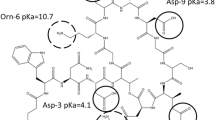Abstract
Background
Limited data are available on the pharmacokinetics and optimal dosage of daptomycin, a lipopeptide compound possessing activity against Gram-positive bacteria, in the pediatric population, particularly in neonates and infants. We determined serum levels of daptomycin in hospitalized pediatric patients treated with various dosages of this agent.
Methods
Blood samples were obtained from pediatric patients of all ages with normal renal function who had received daptomycin between May 2009 and December 2010. Serum levels prior (“trough”) and 30 min after end of the infusion (“peak”) were determined using an ultra-performance liquid chromatography–UV detection method.
Results
A total of four daptomycin dosages and four patients were studied. Three patients were infants (gestational age: 29–38 weeks, age at sampling 26–65 days) and the fourth was a 7-year-old boy. A dosage of 6 mg/kg/12 h of daptomycin to the infants resulted in trough concentrations of <4–8.4 mg/l and peak concentrations of 10.9–17.7 mg/l. Comparable levels were observed after one of the infants received a dosage of 11 mg/kg/12 h, while a further dosage increase to 15 mg/kg/12 h yielded peak concentrations of 35.5 mg/l. The 7-year-old child received a daptomycin dosage of 12 mg/kg once daily; trough and peak levels were 4.2 and 103.4 mg/l, respectively.
Conclusions
A dosage of daptomycin 6 mg/kg/12 h in small infants results in lower peak and similar trough concentrations compared with a dosage of 4 mg/kg/day administered to adults. This results suggests that daptomycin dosages of more than 6 mg/kg/12 h may be needed for this pediatric age group to achieve a similar drug exposure as adults.
Similar content being viewed by others
References
Kosmidis C, Levine DP. Daptomycin: pharmacology and clinical use. Expert Opin Pharmacother. 2010;11:615–25.
Eisenstein BI, Oleson FB Jr, Baltz RH. Daptomycin: from the mountain to the clinic, with essential help from Francis Tally, MD. Clin Infect Dis. 2010;50:S10–5.
Dvorchik BH, Brazier D, DeBruin MF, Arbeit RD. Daptomycin pharmacokinetics and safety following administration of escalating doses once daily to healthy subjects. Antimicrob Agents Chemother. 2003;47:1318–23.
Benvenuto M, Benziger DP, Yankelev S, Vigliani G. Pharmacokinetics and tolerability of daptomycin at doses up to 12 milligrams per kilogram of body weight once daily in healthy volunteers. Antimicrob Agents Chemother. 2006;50:3245–9.
Ardura MI, Mejias A, Katz KS, Revell P, McCracken GH Jr, Sanchez PJ. Daptomycin therapy for invasive Gram-positive bacterial infections in children. Pediatr Infect Dis J. 2007;26:1128–32.
Abdel-Rahman SM, Benziger DP, Jacobs RF, Jafri HS, Hong EF, Kearns GL. Single-dose pharmacokinetics of daptomycin in children with suspected or proved gram-positive infections. Pediatr Infect Dis J. 2008;27:330–4.
Abdel-Rahman SM, Chandorkar G, Akins RL, Bradley JS, Jacobs RF, Donovan J, et al. Single-dose pharmacokinetics and tolerability of daptomycin 8–10 mg/kg in children aged 2–6 years with suspected or proved Gram-Positive infections. Pediatr Infect Dis J. 2011;30(8):712–4.
Cohen-Wolkowiez M, Smith PB, Benjamin DK Jr, Fowler VG Jr, Wade KC. Daptomycin use in infants: report of two cases with peak and trough drug concentrations. J Perinatol. 2008;28:233–4.
Sarafidis K, Iosifidis E, Gikas E, Tsivitanidou M, Drossou-Agakidou V, Roilides E. Daptomycin use in a neonate: serum level monitoring and outcome. Am J Perinatol. 2010;27:421–4.
Chakraborty A, Roy S, Loeffler J, Chaves RL. Comparison of the pharmacokinetics, safety and tolerability of daptomycin in healthy adult volunteers following intravenous administration by 30 min infusion or 2 min injection. J Antimicrob Chemother. 2009;64:151–8.
Anderson BJ, Holford NH. Tips and traps analyzing pediatric PK data. Paediatr Anaesth. 2011;21:222–37.
Marik PE. Aminoglycoside volume of distribution and illness severity in critically ill septic patients. Anaesth Intensive Care. 1993;21:172–3.
Hosein S, Udy AA, Lipman J. Physiological changes in the critically ill patient with sepsis. Curr Pharm Biotechnol [Epub ahead of print]. 2011.
Safdar N, Andes D, Craig WA. In vivo pharmacodynamic activity of daptomycin. Antimicrob Agents Chemother. 2004;48:63–8.
Acknowledgments
We thank the medical and nursing staff of the 1st Department of Neonatology and the 3rd Department of Pediatrics, Aristotle University of Thessaloniki, for their valuable collaboration in this study.
Conflict of interest
None.
Author information
Authors and Affiliations
Corresponding author
Rights and permissions
About this article
Cite this article
Antachopoulos, C., Iosifidis, E., Sarafidis, K. et al. Serum levels of daptomycin in pediatric patients. Infection 40, 367–371 (2012). https://doi.org/10.1007/s15010-011-0240-3
Received:
Accepted:
Published:
Issue Date:
DOI: https://doi.org/10.1007/s15010-011-0240-3




